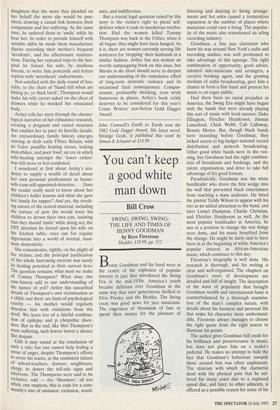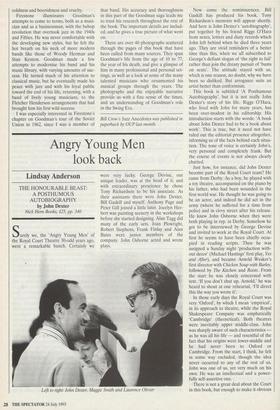You can't keep a good white man down
Bill Crow
SWING, SWING, SWING: THE LIFE AND TIMES OF BENNY GOODMAN by Ross Firestone Hodder, £18.99, pp. 512 Benny Goodman and his band were at the centre of the explosion of popular interest in jazz that introduced the Swing Era in the mid-1930s. America's youth became delirious over Goodman in the same way that later generations thrilled to Elvis Presley and the Beatles. The Swing craze was good news for jazz musicians. The eagerness of thousands of fans to spend their money for the pleasure of
listening and dancing to Swing arrange- ments and hot solos caused a tremendous expansion in the number of places whete musicians could earn a living. The popular- ity of the music also reawakened an ailing recording industry.
Goodman, a fine jazz clarinetist who knew his way around New York's radio and recording studios, was well positioned to take advantage of this upsurge. The right combination of opportunity, good advice, talented side-musicians and arrangers, a creative booking agent, and the growing medium of radio broadcasting, gave him a chance to form a fine band and present his music to an eager public.
Had there been no racial prejudice in America, the Swing Era might have begun with the bands that were already playing this sort of music with local success: Duke Ellington, Fletcher Henderson, Jimmie Lunceford, Chick Webb, Cab Calloway, Bennie Moten. But, though black bands were recording before Goodman, they lacked access to big-budget national record distribution and network broadcasting. Other good white bands were in the run- ning, but Goodman had the right combina- tion of broadcasts and bookings, and the talent, organisation, and drive to take full advantage of his good fortune.
Paradoxically, Goodman was the white bandleader who drove the first wedge into the wall that prevented black entertainers from reaching a mass audience. He hired the pianist Teddy Wilson to appear with his trio as an added attraction to the band, and later Lionel Hampton, Charlie Christian, and Fletcher Henderson as well. As the most popular bandleader in America, he was in a position to change the way things were done, and his music benefited from the change. He might be fairly said to have been in at the beginning of white America's popular interest in African-American music, which continues to this day.
Firestone's biography is well done. His research is thorough, and his writing is clear and well-organised. The chapters on Goodman's years of development are detailed and full of insight. The description of the wave of popularity that brought Goodman wealth and international fame is counterbalanced by a thorough examina- tion of the man's complex nature, with details about his business and personal life that make his character more understand- able. Firestone always manages to choose the right quote from the right source to illustrate his points.
The author gives Goodman full credit for his brilliance and perserverance in music, but does not place him on a zealot's pedestal. He makes no attempt to hide the fact that Goodman's behaviour towards those around him was often unpleasant. The stoicism with which the clarinetist dealt with the physical pain that he suf- fered for many years due to a ruptured spinal disc, and later, to other ailments, is offered as a possible reason for some of his coldness and boorishness and cruelty.
Firestone illuminates Goodman's attempts to come to terms, both as a musi- cian and as a businessman, with the bebop revolution that overtook jazz in the 1940s and Fifties. He was never comfortable with the developing new styles, but he felt the hot breath on his neck of more modern bands like those of Woody Herman and Stan Kenton. Goodman made a few attempts to modernise his band and his music library, with varying amounts of suc- cess. He turned much of his attention to classical music, but he eventually made his peace with jazz and with his loyal public toward the end of his life, returning, with a band of lively young musicians, to the Fletcher Henderson arrangements that had brought him his first wild success.
I was especially interested in Firestone's chapter on Goodman's tour of the Soviet Union in 1962, since I was a member of that band. His accuracy and thoroughness in this part of the Goodman saga leads me to trust his research throughout the rest of the book. The important details are includ- ed, and he gives a true picture of what went on.
There are over 40 photographs scattered through the pages of this book that have been culled from many sources. They span Goodman's life from the age of 10 to 77, the year of his death, and give a glimpse of him in many professional and personal set- tings, as well as a look at some of the many talented musicians who ornamented his musical groups through the years. The photographs and the enjoyable narrative provide us with a fine sense of the times, and an understanding of Goodman's role in the Swing Era.
Bill Crow's Jazz Anecdotes was published in paperback by OUP last month.



















































 Previous page
Previous page